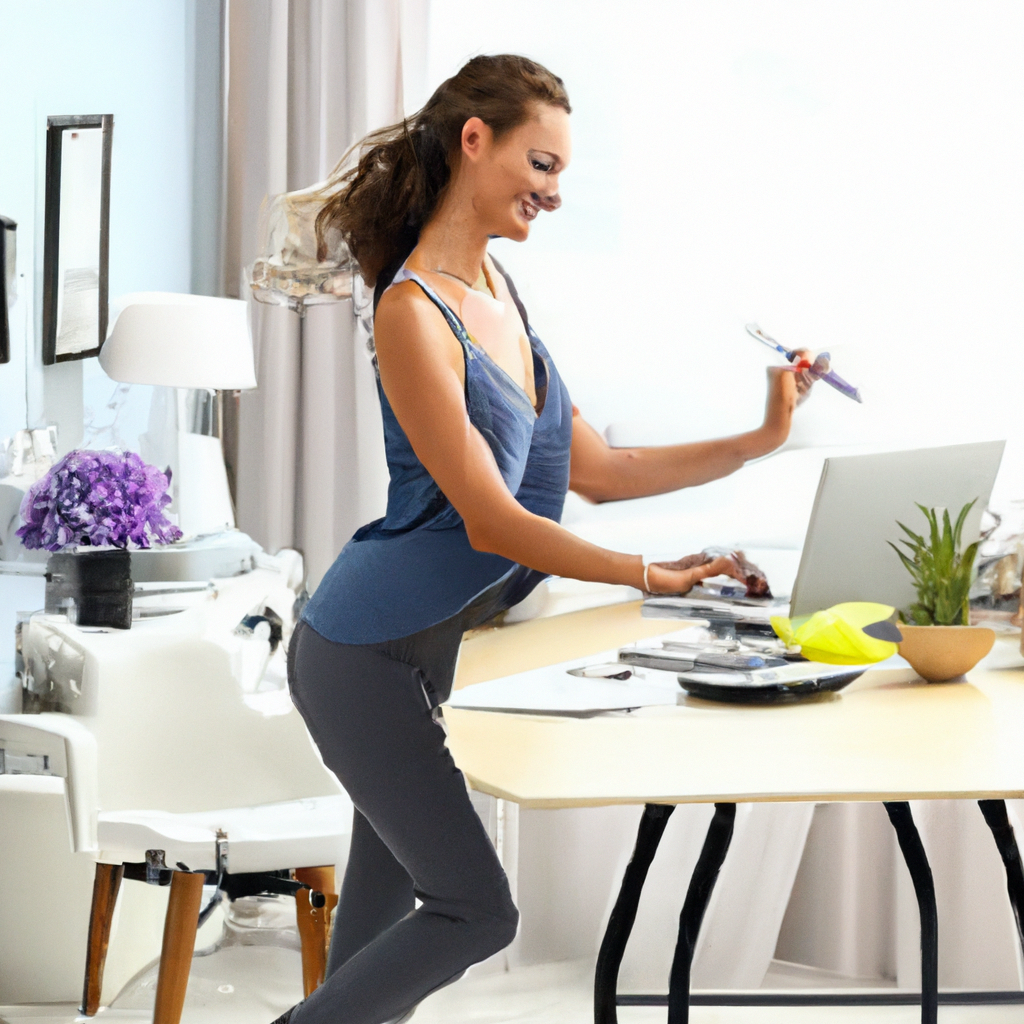
10 Ergonomic Solutions For A Healthy Home Workspace
Setting up a comfortable and healthy home workspace is essential for your overall well-being and productivity. In this article, you will discover 10 effective ergonomic solutions that will help optimize your work environment. From adjustable desks to supportive chairs and proper lighting, these solutions will ensure that you can work comfortably and efficiently, without sacrificing your health. Say goodbye to discomfort and hello to a productive and healthy work-from-home experience!
1. Ergonomic Chair
Investing in an ergonomic chair is crucial for maintaining a healthy and comfortable home workspace. An ergonomic chair offers a range of features designed to support your body and promote good posture. One of the key features is adjustable seat height, which allows you to customize the chair to your specific needs. This means you can set the chair at a height that ensures your feet are flat on the ground and your knees are at a 90-degree angle.
Another important feature of an ergonomic chair is lumbar support. This helps to maintain the natural curve of your spine and prevent lower back pain. Look for a chair with adjustable lumbar support so you can customize the level of support to your preference.
Adjustable armrests are also a must-have feature in an ergonomic chair. These allow you to position your arms comfortably, reducing strain on your shoulders and neck. Make sure the armrests can be adjusted both in height and width to accommodate individuals of different sizes.
Lastly, choose a chair with breathable fabric. This will help to keep you cool and comfortable, especially during long work hours. Look for chairs made of materials like mesh that promote airflow and prevent sweating.
2. Adjustable Desk
An adjustable desk is an essential component of a healthy home workspace. Sitting for long periods can lead to various health issues, including lower back pain and poor circulation. Therefore, having a height-adjustable desk allows you to alternate between sitting and standing throughout the day, promoting better blood flow and reducing the strain on your back.
When selecting an adjustable desk, ensure that it offers a spacious work surface. This will provide ample space to accommodate your laptop or desktop computer, monitor, keyboard, and other essentials without feeling cramped. A clutter-free workspace leads to improved productivity and a more organized mind.
Sturdy construction is another factor to consider when choosing an adjustable desk. A robust desk will ensure stability and prevent wobbling or shaking while you work. It’s important to opt for a desk that can support the weight of your equipment and withstand regular adjustments without compromising its durability.
Furthermore, a smooth adjustment mechanism is essential for hassle-free transitions between sitting and standing positions. Look for desks with easy-to-use mechanisms that allow for effortless height adjustments. This will ensure that you can switch positions smoothly and without any strain on your muscles or joints.
3. Monitor Positioning
Proper monitor positioning plays a significant role in maintaining good posture and reducing strain on your neck and eyes. The first aspect to consider is eye-level placement. Your monitor should be positioned directly in front of you at eye level. This will prevent you from constantly tilting your head up or down, reducing strain on your neck muscles.
The distance between your eyes and the monitor is equally important. Ideally, the monitor should be positioned at an arm’s length away from you. This distance ensures that you can comfortably view the screen without straining your eyes or leaning forward excessively.
To achieve the perfect monitor placement, consider using a monitor stand or arm. These accessories allow for easy adjustment of the monitor height and angle, providing flexibility and customization to suit your individual needs. This way, you can create an ergonomic setup that minimizes discomfort and promotes healthy posture.
4. Keyboard and Mouse
The keyboard and mouse are two primary tools we use extensively while working at a desk. It is important to choose ergonomic options that prioritize comfort and minimize the risk of repetitive strain injuries.
An ergonomic keyboard with wrist support is a great investment. These keyboards are designed to reduce strain on your wrists and promote a more natural hand position. The built-in wrist support provides cushioning and helps alleviate pressure on the wrists, allowing for a more comfortable typing experience.
When it comes to the mouse, opt for a wireless model with a comfortable grip. This will ensure that you can use the mouse without strain or discomfort. Look for a mouse that fits comfortably in your hand and offers adjustable sensitivity to suit your preferences.
Proper positioning of the keyboard and mouse is just as important as selecting ergonomic options. Position the keyboard and mouse close to the edge of the desk, allowing your elbows to rest comfortably at your sides and forming a 90-degree angle. This position helps to minimize strain on your shoulders and wrists, reducing the risk of repetitive strain injuries.
5. Footrest
While often overlooked, a footrest can greatly contribute to a healthy and ergonomic workspace. It provides support and helps ensure proper blood circulation in your lower body. When sitting for long periods, it’s common for your feet to dangle or rest on the tiptoes, leading to discomfort and reduced circulation.
An adjustable footrest allows you to find the ideal height that keeps your feet flat on the surface, with your knees at a 90-degree angle. This promotes proper posture and helps alleviate pressure on your lower back by distributing your weight more evenly.
Additionally, opt for a footrest with a non-slip surface. This ensures that your feet stay securely in place and prevents any accidental slipping or sliding.
6. Lighting
Proper lighting is essential for a comfortable and productive home workspace. Insufficient or harsh lighting can strain your eyes and cause headaches, while excessive glare can make it difficult to see your screens clearly. Here are some tips for achieving optimal lighting:
Start by maximizing natural light in your workspace. Position your desk near a window to take advantage of natural sunlight. Natural light not only helps reduce eye strain but also improves overall mood and well-being. Just ensure that the sunlight does not directly hit your monitors, causing glare or reflections.
In addition to natural light, consider adding an adjustable desk lamp. A desk lamp with adjustable brightness and color temperature allows you to customize the lighting according to your needs. Proper lighting is especially crucial during evening work sessions or when working in dimly lit rooms.
To avoid glare and shadows, position the desk lamp to the side of your workspace, opposite from where you use your dominant hand. This will help eliminate shadows on your work surface and prevent any direct light from creating glares on your screen.

7. Noise Reduction
Minimizing distractions and creating a quiet work environment is essential for maintaining focus and productivity. Noise reduction techniques can help achieve a more peaceful workspace. Here are some effective solutions to consider:
Investing in soundproofing materials is a great way to reduce external noise. Acoustic panels can be installed on walls or ceilings to absorb sound waves and minimize echo. Additionally, using thick curtains or blinds can help block out noise coming from outside your workspace.
A white noise machine can also be a valuable tool in creating a calm environment. White noise machines emit a consistent and soothing sound that can mask other distracting noises, allowing you to concentrate better on your work.
Alternatively, consider using noise-canceling headphones. These headphones are designed to block out background noise, allowing you to focus on your tasks without interruptions. With the ability to listen to music or ambient sounds while canceling out external noise, noise-canceling headphones can greatly enhance your work experience.
8. Cable Management
A clutter-free and organized workspace not only enhances aesthetics but also reduces the risk of accidents and promotes mental clarity. Proper cable management is crucial in achieving a tidy workspace. Here’s how you can keep your cables neat and organized:
Use organizer clips or cable sleeves to bundle and secure your cables. These accessories help prevent tangling and keep your cables in order. You can easily attach these clips or sleeves to the edge of your desk or use adhesive backing to keep them in place.
Arrange your cables in a way that avoids tangles and minimizes their visibility. One effective method is to use cable management clips or hooks to route your cables along the back or underside of your desk. This helps keep them out of sight and prevents them from getting entangled with your feet or other objects.
Safety should also be a priority when managing cables. Ensure that your cables are not stretched or bent excessively, as this can cause damage to the wires and increase the risk of electrical hazards. Use cable ties or Velcro straps to secure any excess cable length and prevent tripping hazards.

9. Ergonomic Accessories
In addition to the major components of your workspace, there are several ergonomic accessories that can further enhance your comfort and productivity. Here are a few accessories worth considering:
Wrist rests provide support and cushioning for your wrists while typing. They help reduce strain and prevent discomfort caused by prolonged keyboard use. Look for wrist rests made of ergonomic materials that offer proper wrist alignment and comfort.
Laptop stands are a valuable accessory if you use a laptop regularly. Elevating your laptop to eye level helps maintain good posture and reduces strain on your neck and shoulders. Choose a stand that offers adjustable height and tilt angles to find the optimal position for your viewing comfort.
Document holders can be useful if you frequently reference physical documents while working at your desk. These holders keep your documents at eye level, allowing you to maintain a more ergonomic posture and reducing strain on your neck. Look for holders that offer adjustable angles and are compatible with different document sizes.
Phone stands are essential if you use your smartphone for work-related tasks. Placing your phone on a stand prevents you from constantly looking down at your screen, reducing strain on your neck and promoting better posture. Look for stands that offer adjustable angles and stable support for your phone.
10. Mental Health Support
Caring for your mental well-being is equally important as maintaining good physical health in your home workspace. Here are some strategies to support your mental health:
Create a positive work environment by personalizing your workspace with items that bring you joy and inspiration. Decorate with plants, artwork, or photographs that contribute to a calming and uplifting ambiance. Incorporate colors and textures that make you feel relaxed and motivated.
Take regular breaks throughout the day to relax and recharge. It’s important to step away from your desk and engage in activities that help reset your mind. Stretch, practice deep breathing exercises, or take a short walk to refresh and rejuvenate yourself.
Maintain regular communication and social interactions with colleagues, friends, and family. Working from home can be isolating, so make an effort to stay connected with your support network. Schedule video calls or virtual coffee breaks to foster a sense of belonging and combat feelings of loneliness.
If you find yourself struggling with your mental health, don’t hesitate to seek professional help. Reach out to a therapist or counselor who can provide guidance and support. Your mental well-being should always be a priority, and seeking help is a sign of strength, not weakness.
In conclusion, creating a healthy home workspace requires careful consideration of various ergonomic solutions. From investing in an ergonomic chair to optimizing lighting and managing cables, every aspect plays a role in promoting comfort, productivity, and overall well-being. By implementing these 15 ergonomic solutions, you can create a workspace that supports your physical and mental health, allowing you to thrive in your work-from-home environment.




